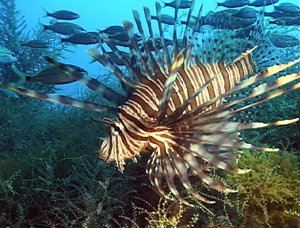Unlike other local fish, invasive lionfish is a species fishermen want to wipe out. In 2010, NOAA developed an Eat Lionfish campaign that brought together fishermen, seafood wholesalers and restaurants to market the invasive predators to consumers.
With the same goal in mind, fishermen in Florida and the Caribbean have been holding lionfish derbies with cash prizes for catching the most fish. In the Cayman Islands, for example, fishermen and divers have formed Cayman United Lionfish League, or CULL. During a tournament in January, groups of divers bagged more than 1,000 of the spiny creatures, which they followed with a celebration where lionfish dishes were served at local restaurants.
Importing lionfish works against local efforts to cull the invasive species. NOAA photoIn some ways, the campaigns have been successful: With delicate, white meat that has been called similar to grouper and snapper, lionfish quickly became a favorite with diners. But now, at least in the Caymans, they've run into a problem faced by other local fish species: They're too expensive and can't compete with cheaper imports. Some restaurants there began importing lionfish from Honduras, which at $2 per pound, is much cheaper than the locally caught ones. For its part, CULL launched an additional campaign to support restaurants that serve lionfish caught in local waters. (And ideally lionfish from Honduras could became a more sustainable option for cheap imported whitefish elsewhere.)
There should be plenty from local waters, unfortunately. Since it invaded South Atlantic waters in the mid 1980s, according to NOAA — though some think it escaped a private aquarium during Hurricane Andrew in 1992 — lionfish has been thriving off Florida and in the Caribbean with a range that stretches from South America to North Carolina.
Originally reef dwellers in the South Pacific and Indian oceans, the spiny species will eat almost any fish smaller than it is and has no known predators (except for man). Though there's no way to count them, the signs are troubling. They've been found in water 300-feet deep, meaning they're a threat to native species at various depths, and when researchers have tried to count them, they've added up more than 3,000 fish in an area roughly the size of a football field.
So what can we do? Researchers have been looking into what has curbed the lionfish from completely taking over its home territory for a possible way to control its population here. So far they've found no solutions. It looks like the best choice is to keep culling and keep eating them. Groups like CULL should be commended and supported for their efforts in raising the culinary profile of the species. In this case, buying local means not only sustaining local fishermen but also helping to protect the viability of an entire ecosystem.







